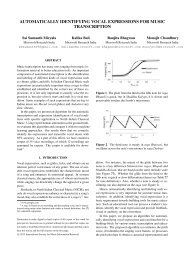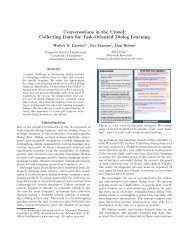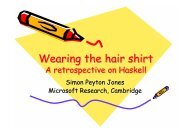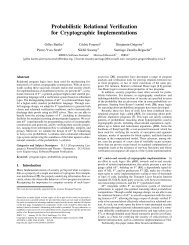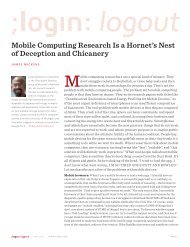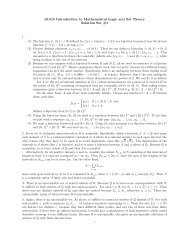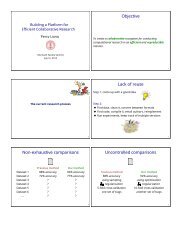A Moving Target—The Evolution of Human-Computer Interaction
A Moving Target—The Evolution of Human-Computer Interaction
A Moving Target—The Evolution of Human-Computer Interaction
You also want an ePaper? Increase the reach of your titles
YUMPU automatically turns print PDFs into web optimized ePapers that Google loves.
Wikipedia, multiplayer games, and other Web phenomena. These are <strong>of</strong> intrinsic interest to students, and the primarily<br />
North American s<strong>of</strong>tware companies that produce them vie to hire good students and consult with strong senior<br />
researchers. These technologies are not yet <strong>of</strong> great interest to the organizations and government agencies that are<br />
the customer for European CSCW research. The convergence <strong>of</strong> CSCW and ECSCW interests has been undone.<br />
Europeans are more focused on basic research in vertical domains. The division resembles that <strong>of</strong> 20 years ago,<br />
brought about by a new generation <strong>of</strong> technology. In time the two research threads may again converge, perhaps<br />
under a new name: “computer supported cooperative work” is outdated. Many digital devices are not considered<br />
computers, they play central rather than support roles, activities around them can be competitive or conflictual, and<br />
they may be used more for recreation than work.<br />
The Web curtailed research into one thread <strong>of</strong> AI research: powerful, self-contained personal productivity tools.<br />
Considerable effort is required to embed knowledge in application s<strong>of</strong>tware. When access to external information<br />
sources was limited, it was worth trying to embed static, self-contained knowledge, but with today’s easy access to<br />
information and knowledgeable people online, it is not promising. In contrast, adaptive systems that merge and filter<br />
local and Internet-based information have a role to play. Steady progress in machine learning is enhancing productivity<br />
tools—although implausible AI forecasts <strong>of</strong> the ultra-intelligent Singularity still bloom.<br />
To the psychologists and computer scientists who formed the early CHI community, interface design was a matter<br />
<strong>of</strong> science and engineering. They focused on performance and assumed that people eventually choose efficient alternatives.<br />
Because human discretion involves aesthetic preferences and invites marketing and non-rational persuasion,<br />
this view was not sustained when computing costs came down. This engineering orientation gripped CHI longer<br />
than SIGGRAPH, where aesthetic appeal was a major driver. CHI researchers eventually came around, labeling the<br />
study <strong>of</strong> enjoyment “funology” (Blythe et al., 2003) lest someone think that they were having too good a time.<br />
Some visual designers participated in graphical interface research early on. Aaron Marcus began working full time<br />
on computer graphics in the late 1960s. William Bowman’s 1968 book Graphic Communication was a strong influence<br />
on the design <strong>of</strong> the Xerox Star, for which the designer Norm Cox’s icons were chosen (Bewley et al., 1983).<br />
However, graphic design was considered a secondary activity (Evenson, 2005). In 1995, building on workshops at<br />
previous conferences, SIGCHI initiated Designing Interactive Systems (DIS), a biennial conference. Despite aspirations<br />
to be broader, DIS draws more system designers than visual designers. In 2003, SIGCHI, SIGGRAPH, and the<br />
American Institute <strong>of</strong> Graphic Arts (AIGA) initiated the Designing for User Experience (DUX) conference series that<br />
fully embraced visual and commercial design. The collaboration lasted only through 2007, but it established the significance<br />
<strong>of</strong> Design, which is not typically assessed in research papers. The changing sensibility is reflected in ACM<br />
<strong>Interaction</strong>s, a magazine launched by CHI in 1994, which has steadily increased the focus on visual design, in both<br />
its content and its appearance.<br />
Design’s first cousin, marketing, has been poorly regarded by the CHI community (Marcus, 2004). Web site design<br />
forces the issue. Site owners wish to keep users at a site, whereas users may prefer to escape quickly. Consider<br />
supermarkets, which position items that most shoppers want far apart, forcing people to traverse aisles where other<br />
products beckon. CHI pr<strong>of</strong>essionals who align themselves with 'end users' face a stakeholder conflict when designing<br />
for a web site owner. This was not true in the past: Designers <strong>of</strong> individual productivity tools had little conflict <strong>of</strong> interest<br />
with prospective customers. Marketing is concerned with identifying and satisfying user needs, as well as shaping<br />
them. It will likely find a place in CHI, perhaps labeled ‘brandology.’<br />
Finally, CHI has gradually become more open to work that takes a social or political stance. Accessibility was first<br />
addressed in the context <strong>of</strong> physical constraints. Socioeconomic factors were included in Universal Usability conferences<br />
in 2000 and 2003. Sustainability and fitness have emerged as topics. This may reflect a distancing from a<br />
sense that engineering should strive for value neutrality, or it could be a bid for relevance by an increasingly academic<br />
group, or reflect aging CHI baby boomers who are considering their legacies.<br />
The evolution <strong>of</strong> CHI is reflected in the influential contributions <strong>of</strong> Donald Norman. A cognitive scientist who introduced<br />
the term cognitive engineering, he presented the first CHI 83 paper. It defined 'user satisfaction functions'<br />
based on speed <strong>of</strong> use, ease <strong>of</strong> learning, required knowledge, and errors. His influential 1988 book Psychology <strong>of</strong><br />
Everyday Things (POET) focused on pragmatic usability. Its 1990 reissue as Design <strong>of</strong> Everyday Things reflected a<br />
field refocusing on invention. Fourteen years later he published Emotional Design: Why We Love (or Hate) Everyday<br />
Things, stressing the role <strong>of</strong> aesthetics in our response to objects.<br />
LOOKING BACK: CULTURES AND BRIDGES<br />
Despite overlapping interests, in a dynamic environment with shifting alliances, the major threads <strong>of</strong> humancomputer<br />
interaction research—human factors and ergonomics, information systems, library and information science,<br />
and computer-human interaction—have not merged. They have interacted with each other only sporadically,<br />
although not for lack <strong>of</strong> bridge-building efforts. The <strong>Human</strong> Factors Society co-organized the first CHI conference.<br />
CSCW sought to link CHI and IS. Mergers <strong>of</strong> OIS with CHI and later CSCW were considered. AIS SIGHCI tried to<br />
28



